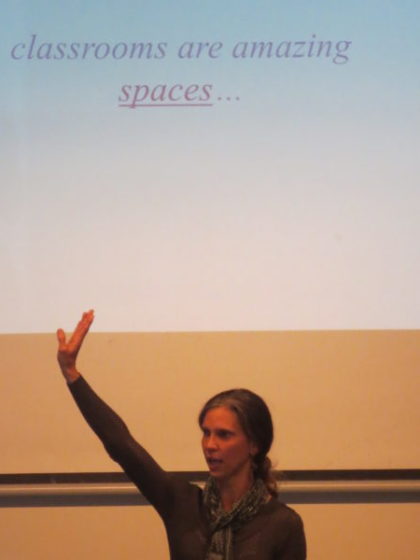Blog
Voicing the individual and the collective in our classrooms
By Debbie Cole (Associate professor of English and Intercultural Communication) and Geke Niemann (BA student, English Language and Culture major)
One of the most interesting things about classrooms is that they bring together people who learn in overlapping but not exactly the same ways. In contemporary education talk, we say students come to our courses with different learning styles and will likely make use of different learning strategies. We encourage ourselves to create student-centered curricula that acknowledge these differences, but when faced with pressure to standardize materials, and in the name of making things “fair” for everyone, we often approach our courses using the “tried and true” ways of doing things that have worked for us as students and teachers in the past. Without the time and space to figure out what works best for our individual students or to explore other methods that may work best for individual teachers, we remain unaware of the conditions we can create to make the learning experience fit the widest range of abilities and preferences in our classrooms.
“No matter how we teach or learn, any given assignment, presentation method, or pedagogical approach will not be evenly ideal for every person.”
Debbie: One day about five years ago while giving a lecture about first language acquisition in young humans, I decided to play recordings of local bird songs. We were examining Noam Chomsky’s idea that human language is “acquired” and not learned in the sense that we normally think of as learning, and I wanted the students to consider bird-song as a comparative case for human language acquisition. I played the recordings as “background music” to prompt their recognition of any local bird songs they had heard, hoping to stimulate discussion.
Several minutes into the lecture, I stopped the bird song recordings to move on to the next topic, but it occurred to me to ask the students how they had experienced the birds singing during the lecture. As we often do, I initiated an impromptu survey and asked them to raise their hands if they had found the bird songs distracting. The students that I had subconsciously identified as “good students” – the ones who always looked like they were paying attention, giving me good non-verbal feedback and ready to answer my questions – raised their hands. I then asked how many of them had not found it distracting. About half of them raised their hands. They said it enhanced their listening experience. One student said that listening to the lecture with the birds singing, she felt, for the first time, that she could truly pay attention during lecture.
Geke: Recently I was asked to provide an answer to the question, “what makes a good teacher according to you?” I realized that my idea of a good teacher is largely based on the teaching styles of my favourite teachers and that, even now, memories of their classes make me smile. When I compare their teaching styles, there is one thing they all have in common: good teachers are teachers who give each and every student the opportunity to be the best individual version of him- or herself and at the same time succeed in connecting the class as a whole. They provide their students with the tools they need, but do not deprive them from the opportunity to learn for themselves.
Out of the many examples from my secondary school experiences, here are two situations that illustrate what I mean. In one English course, we wrote and produced our own mini-movie. All students had a task they were happy with, and during one of the last classes of the year we watched the movie we made together. Our teacher challenged us throughout the project: We were asked to combine our creativity using the language skills we had obtained thus far. Whether you wrote the script, acted in front of the camera or helped behind the scenes, every student actively engaged in the process. Instead of completing standardized exercises to demonstrate a specific skill, we created our own exercises in which we could combine all of our skills. A few years later, we once had the opportunity to choose our own course-material in a Latin class. Our teacher ended up making three different tests, including one covering a Latin version of Harry Potter. Although using different approaches, both of these teachers gave us the freedom to study their subject out of one standardized context. In letting us work together, but in our own ways, our teachers helped us realize that every individual classmate had different talents, and that we could create beautiful things by combining them.
That the combination of different voices can create beautiful things, was illustrated clearly during the “Voicing the individual and the collective” singing workshop at TAUU’s lustrum event in June. After a short introduction, we formed a circle and soon started to sing together. Our workshop leader, Nicoline Snaas, paid attention to how we formed a collective voice. The approach with which we had started soon caused the men in our group to adjust their pitch to the women’s voices, and they were thus not able to sing in their most ideal or natural ranges. Quickly changing approach, Nicoline divided our circle into a male and a female side, after which the men succeeded in regaining their own pitch range. As a next step we began singing a cannon, starting out with one melody, later extending this into several different melodies Nicoline walked around and listened to every individual voice, and she decided once more to give some people a new place within our circle.
I (Geke) was one of the people she moved and who ended up standing in “the men’s half” of the circle. Afterwards I asked her why she had decided to make these adjustments. I told her the change of position had slightly confused me since I did not necessarily consider the pitch of my voice to be low. She answered that indeed the pitch of my voice was not low. However, I had not been able to quickly adapt to the melody sung by the others in the part of the circle where I had been originally standing and had instead been following the melody sung by the men. So she had decided to move me where my voice seemed to want to go. By individualizing her approach towards the group, everyone was able to sing in a manner that was most natural to them, and in the combination of all our own voices there arose a harmonious melody, which we described in discussion afterwards as a feeling of connection.
What can we learn from these examples? Perhaps the things we do in our courses that appear to work well may in fact only really work well for a subset of the classroom participants. The rest of us may manage to be successful at schooling while never having the opportunity to learn in our ideal ways. No matter how we teach or learn, any given assignment, presentation method, or pedagogical approach will not be evenly ideal for every person. Faced with this knowledge, we can continue to offer a single approach in our courses that inevitably plays to the strengths of particular students. Or, we can choose to mix it up and try different approaches that more evenly distribute the effort that’s needed and the satisfaction that can be gained by each individual who is learning in our group.
Photo: Debbie Cole presenting her keynote at the TAUU lustrum event, June 2017.

 28 september 2017
28 september 2017
U moet ingelogd zijn om te reageren, gebruik het formulier aan de linkerkant om in te loggen met uw solis gegevens.


